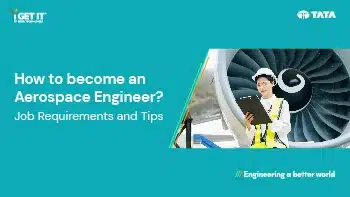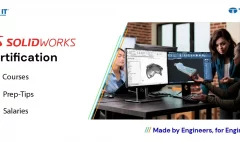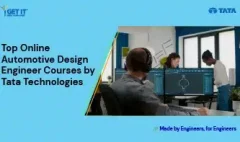How to Become an Aerospace Engineer?-Job Requirements & Tips
August 1, 2024 2024-10-15 13:01How to Become an Aerospace Engineer?-Job Requirements & Tips
How to Become an Aerospace Engineer?-Job Requirements & Tips
Embarking on a career in aerospace domain is akin to holding the key to unlocking the mysteries of the skies. It is a field where imagination knows no bounds, where the laws of physics, digital technologies synergies and data science merge with the dreams of humanity to create machines and ecosystem that defy gravity and explore the great unknown while brining ultimate and delighting experience to consumers. Aerospace engineers, digital stalwart, process architects and creative collaborators are the architects of innovation, the creators of vehicles that soar through the heavens and touch the edges of space. Understanding how to become an aerospace engineer is essential for those who aspire to join these ranks of innovation and creativity.
With each design, each calculation, and each successful mission, they push the boundaries of what is possible, shaping the future of flight and space exploration. Where working does not seems like working, it’s game of learning, experiments and personal transformation where human potential, intelligence and emotions get together to bring best of best within us.
Table of Contents
With each design, each calculation, and each successful mission, these innovators push the boundaries of what is possible, shaping the future of flight and space exploration. Where working does not seems like working, it’s game of learning, experiments and personal transformation where human potential, intelligence and emotions get together to bring best of best within us.

How hard is it to become an Aerospace Engineer?
The greatest myth around career in aerospace domain is that, someone with Aerospace Engineering or with very specialised courses (similar to Aerospace Engineering) only can have a great career. So, it becomes very imperative to understand the dynamics of this industry so that we can craft our career and while enjoying our own transformational journey. I would like to bring insights, understanding and insights through some stories and my experiment with life and professional career. While a career in aerospace engineering may seem daunting, it is entirely achievable with hard work, dedication, and the right guidance. To achieve this dream most important thing is to have willingness to learn.
In our childhood, we always heard that we must be different, completely different from others in everything, whether its studies, extra-curricular activities, knowledge about aircraft, aviation, space, satellite etc. Even our engineering stream should be aerospace / aeronautical / aviation, only then we are qualified to think about career in aerospace industry. Today I would like to share few stories and experiences that will help to understand, what exactly needed to build career in aerospace industry.
Note: Aerospace and aviation are terms that are often used interchangeably, but they encompass different scopes and areas of study and industry. Aerospace is a broader field that encompasses the study, design, and production of both aircraft and spacecraft. It includes all the activities related to flight within Earth’s atmosphere (aeronautics) and beyond (astronautics). Where as Aviation is a subfield of aerospace that specifically deals with the design, development, production, operation, and maintenance of aircraft. It is primarily concerned with air travel and transportation within the Earth’s atmosphere. Further to this, Aeronautics deals with the science and engineering of aircraft operating within Earth’s atmosphere and Astronautics focuses on the science and technology of spacecraft and space travel.
The Aviation Industry and its entire ecosystem
On an average there are approximately 10,000 aircraft flying in the air, at any given point of time (this is average data for approximation, in general it varies from 8000 to 20000 depending on various factors) and even though aircraft is widely regarded as the safest model of travel.

So, it’s not only the design and manufacturing of Aircraft that matters for us. It’s ecosystem of aviation industry that comes in play to help us fly in safest travel mode in fastest possible time. The aviation industry is a vast and intricate ecosystem comprising various stakeholders, each playing a vital role in ensuring the smooth operation of air travel and related services. This ecosystem includes following elements. Understanding how these components interact is crucial for grasping the complexities and dynamics of the aviation industry.
- Airlines: Airlines are the most visible component of the aviation ecosystem. They operate aircraft to transport passengers and cargo from one location to another
- Airports: Airports are critical infrastructure facilitating the take-off, landing, and maintenance of aircraft, as well as passenger and cargo handling
- Regulatory Bodies: Regulatory bodies ensure the safety, security, and efficiency of the aviation industry through stringent regulations and oversight (for ex. CAO, FAA, EASA etc.)
- Aircraft Manufacturers: Aircraft manufacturers design, produce, and sell aircraft to airlines, governments, and other entities

5. Maintenance, Repair, and Overhaul (MRO) Providers: MRO providers ensure aircraft are maintained in peak operating condition, adhering to stringent safety standards
6. Service Suppliers: Numerous service suppliers support the aviation industry, providing essential services to both airlines and passengers (ex. Catering, Ground handling, IT & Communication etc.)
7. Passengers and Cargo Customers: The end users of the aviation ecosystem, whose needs and expectations drive the services and operations of the industry
8.Government and Security Agencies: These entities ensure the security and facilitation of air travel, protecting passengers and cargo from various threats (ex. TSA, CBP, NAAs etc.)
9.Industry Associations and Organizations: These organizations represent the interests of various stakeholders and help shape industry policies and practices
The aviation industry is a complex and interconnected ecosystem that relies on the coordinated efforts of numerous stakeholders. Understanding these interactions and the roles of different entities helps to appreciate the intricacies of air travel and the continuous efforts to improve safety, efficiency, and passenger satisfaction. As the industry evolves, innovations in technology, sustainable practices, and enhanced collaboration will be key to addressing future challenges and opportunities.
Theme and purpose of career path in Aerospace domain
Discovering the purpose behind our career is a deeply personal journey that involves self-reflection, exploration, and continuous learning. By understanding our own interests, values, and strengths, and by setting clear goals and seeking guidance, we can find a career path that is not only fulfilling but also meaningful. In current evolving world and algorithmic era, the classical model of choosing career fades with time and eventually it brings boredom and monotonous in professional career over period of time. Based on my experience, we should align our goal with purpose and impact in the industry.
To understand the overall landscape and ecosystem of new evolving business model in this area, let’s refer figure – 2, which focus on more deeper in end to end life cycle of aircraft development and usage. From Aircraft Development (R&D of new Aircraft models/platform) to program execution, delivery to Airline and ultimately brining new paradigm (new business model, revenue model for enterprises) to bring data in core focus to derive back the experience, efficiency, innovation, optimization and real-time closed loop with engineering and manufacturing. (In Figure – 2, we have seen overall ecosystem of aviation industry, which brings end to end view of all stakeholders and organizations)

This diagram represent the futuristic model of organization business model, which will be running based on data at the core and Artificial Intelligence (Algorithmic Insights and Decisions) as DNA. Now let’s get into high level themes. Based on key interactions in the aviation ecosystem, we should pivot our focus around following broader theme to align our goal, regardless of whatever role we play as an individual. These elements will help us to keep our talent and competencies transforming through the time to meet new world challenges:
Collaboration and Coordination: Airlines, airports, and regulatory bodies must collaborate closely to ensure smooth operations. This includes coordinating schedules, adhering to safety regulations, and managing air traffic. The application of latest technologies and Artificial intelligence play key role in having modern and state-of-the-art system, process and technologies to manage business efficiently.
Innovation and Technology: Continuous advancements in technology, such as next-generation aircraft, automation, and data analytics, drive improvements in efficiency, safety, and passenger experience. This is the key area where, the engineering bring the magic. System engineering plays a critical role in aircraft development, ensuring that complex aircraft systems work seamlessly together to meet the stringent requirements for safety, performance, reliability, and efficiency. This interdisciplinary field integrates various engineering disciplines and processes to design, develop, and manage aircraft systems throughout their life cycle. System engineering is fundamental to the successful development of modern aircraft, ensuring that complex systems are designed, integrated, and managed effectively. By focusing on safety, performance, reliability, and regulatory compliance, system engineering enables the creation of aircraft that meet stringent standards and operational demands. Through rigorous processes and the use of advanced tools, system engineers help navigate the challenges of aircraft development, contributing to the advancement of aviation technology.
Economic and Environmental Pressures: The industry faces economic challenges such as fluctuating fuel prices and competitive pressures, as well as the need to reduce its environmental impact through sustainable practices and technologies. Anticipated advancements and scalability of technologies, such as Sustainable Aviation Fuels (SAFs), projected to help reduce greenhouse gas (GHG) emissions by 46%-65%, offer the sector a clear trajectory. The key challenge lies in scaling up the production and supply of SAFs. According to the Mckinsey’ s Making Net-Zero Aviation Possible report, meeting the demand will necessitate 300 SAF production plants by 2030, with a projected requirement of up to 3,400 plants by 2050. The new generation manufacturing facilities (factory of the future) also holds huge potentials to craft a career path with confluence of advance technologies and infrastructure.
Passenger Experience: Enhancing the passenger experience in aerospace involves a comprehensive approach that addresses comfort, entertainment, personalization, sustainability, accessibility, and wellness. Advances in aircraft cabin interiors are a key part of this evolution. By leveraging advanced technologies, innovative designs, and exceptional customer service, airlines and aircraft manufacturers can create a more enjoyable and satisfying travel experience for passengers. This brings-in another zone of fascinating career options.
Job requirements to become an Aerospace Engineer
You must be curious about how to be a successful Aerospace engineer or how to get an aerospace engineering job. Well don’t worry, here is the short summary/checklist for Aerospace Engineer job requirements:
Educational Qualifications:
Bachelor’s degree in aerospace engineering, mechanical engineering, or a related field.
1. Technical Skills:
Strong foundation in mathematics and physics.
Proficiency in engineering software, such as CAD tools.
Deep understanding of aerodynamics, propulsion, and materials science.
2. Personal Skills:
Excellent problem-solving abilities.
Attention to detail.
Strong teamwork and communication skills.
3. Practical Experience:
Internships or cooperative education programs are highly valued.
Hands-on experience provides real-world insights and industry connections.
4. Industry Knowledge:
Staying updated with emerging technologies and innovations in the aerospace sector.
Final thoughts
Crafting a career journey in aerospace, one of the most dynamic and impactful industries in the world brings in tremendous of opportunities for everyone. Whether you are passionate about designing cutting-edge aircraft, exploring the mysteries of space, or advancing sustainable aviation technologies, the aerospace sector offers unparalleled opportunities for innovation and growth. With its blend of engineering excellence, scientific discovery, and technological advancement, a career in aerospace not only promises personal and professional fulfilment but also allows you to contribute to the future of global connectivity and exploration. As you navigate your path, remember that the sky is not the limit—it’s just the beginning.
What to expect in next part of this series?
To enable ourselves with deeper insight of this industry, next series will bring fundamental interplay of systems engineering and digital technologies. Till then, keep your curiosity on with thought full thinking. Always remember, “Each time you settle for what others say is possible, you degrade your vision and reduce your heroism”. Aerospace domain gives us freedom to fly high and the only thing, better than us is the version of ours in coming future…keep flying! To be continued….
About i GET IT by Tata Technologies
i GET IT by Tata Technologies is online learning platform for mechanical engineers and designers. It has extensive 2000+ range of courses, 8+ job role certifications and coverage of 20+ domain topics that makes it a comprehensive hub for engineering education. By offering specialized certifications and personalized learning paths, we ensure that learners not only acquire knowledge but also develop expertise in their chosen fields.
Anant Saurabh
Related Posts
SOLIDWORKS Certification: Top Courses, Prep Tips & Salaries
Top Automotive Design Engineer Courses by Tata Technologies
PLM Teamcenter Interview Questions and Answers – [HR Expert List]
Hybrid Electric Vehicles Webinar With Kedar Gokhale
Best EV Online Courses with Certification by Tata Technologies
Find
Categories
Latest Posts
What Is AutoCAD Software? Uses, Features & Practical Examples
December 18, 2025Independent Front Wheel Suspension – Types, Benefits & Working
November 10, 2025What is PLM? – Product Lifecycle Management [Detailed Guide]
October 9, 2025Popular Tags



















